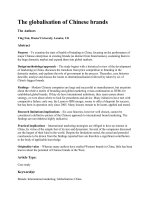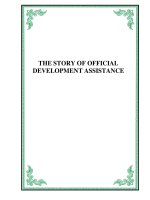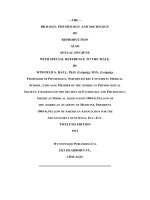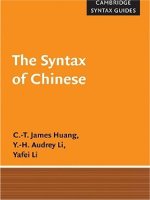The post 1991 ethio china partnership with particular reference to the relevance of chinese development model to ethiopia
Bạn đang xem bản rút gọn của tài liệu. Xem và tải ngay bản đầy đủ của tài liệu tại đây (743.68 KB, 98 trang )
ADDIS ABABA UNIVERSITY
SCHOOL OF GRADUATE STUDIES
THE POST -1991 ETHIO-CHINA
CHINA PARTNERSHIP,
PARTNERSHIP WITH PARTICULAR REFERENCE
TO THE RELEVANCE OF CHINESE DEVELOPMENT MODEL TO ETHIOPIA
By Gereziher Haftu
Advisor Dr. Hussein Jemma
June 2017
1
THE POST-1991 ETHIO-CHINA PARTNERSHIP WITH PARTICULAR REFERENCE TO
THE RELEVANCE OF CHINESE DEVELOPMENT MODEL TO ETHIOPIA
By
Gereziher Haftu
A THESIS SUBMITED TO SCHOOL OF GRADUATE STUDIES OF ADDIS ABABA
UNIVERSITY IN PARTIAL FILFILLEMENT OF THE REQUIREMENTS FOR THE
DEGREE OF MASTERS OF ARTS IN INTERNATIONAL RELATIONS AND DIPLOMACY
Advisor
Dr. Hussein Jemma
ADDIS ABABA UNIVERSITY, COLLEGE OF SOCIAL SCIENCES, DEPARTMENT OF
POLITICAL SCIENCES AND INTERNATIONAL RELATIONS
ADDIS ABABA
June 2017
2
ADDIS ABABA UNIVERSITY
SCHOOL OF GRADUATE STUDIES
THE POST-1991 ETHIO-CHINA PARTNERSHIP WITH PARTICULAR REFERENCE TO
THE RELEVANCE OF CHINESE DEVELOPMENT MODEL TO ETHIOPIA
By Gereziher Haftu
COLLEGE OF SOCIAL SCIENCES, DEPARTMENT OF POLITICAL SCIENCE AND
INTERNATIONAL RELATIONS
APPROVED BY BOARD OF EXAMINERS
________________
____________________
ADVISOR
__________________
SINNITURE
DATE
____________________
INTERNAL EXAMINER
_____________________
EXTERNAL EXAMINER
__________________
SIGNITURE
____________________
DATE
_________________
SIGNITURE
____________________
DATE
3
Declaration
I, the undersigned, declare that this thesis is my own original work and has not been presented
for a degree in any other University and that all sources of material used for the thesis have been
duly acknowledged.
_______________________________
Gereziher Haftu
June 2017
This thesis is submitted for examination with my approval as an advisor of the candidate.
____________________________________
Hussein Jemma (PhD)
June 2017
4
5
Table of Contents
Contents
page
Table of Contents ............................................................................................................................. i
List of Tables ………………………………………………………………………………….....iv
Appendicies.................................................................................................................................... iv
Acknowledgements…………………………………………………………………………...….. v
Accronyoms and Abrivations ……………………………………………………………………vi
Abstract ......................................................................................................................................... vii
CHAPTER ONE ............................................................................................................................. 1
INTRODUCTION ......................................................................................................................... 1
1.1 Background of the Study .......................................................................................................... 1
1.2 Problem Statement .................................................................................................................... 3
1.3 Central Argument...................................................................................................................... 5
1.4. Objectives ................................................................................................................................ 5
1.4.1 Overall Objective .............................................................................................................. 5
1.4.2 Specific Objectives ............................................................................................................ 5
1.5. Research Questions .................................................................................................................. 6
1.5.1 Core Research Question .................................................................................................... 6
1.5.2 Specific Research Questions ............................................................................................. 6
1.6. Methodology and Methods ...................................................................................................... 6
1.6.1 Methodology ..................................................................................................................... 6
1.6.2 Methods: Sources of Data and Instruments of Data Collection and Analysis .................. 7
1.7 Ethical Considerations .............................................................................................................. 8
1.8. Significance of the Study ......................................................................................................... 8
1.9 Scope of the study ..................................................................................................................... 8
1.10 Limitation of the Study ........................................................................................................... 9
1.11 Organization of the Study…………...………………………………………………………9
CHAPTER TWO…………………...…………………………………………………………....10
CONCEPTUAL AND THEORETICAL FRMEWORKS............................................................ 10
2.1 Conceptual Framework ..................................................................................................... 10
i
2.1.1 Partnership............................................................................................................................... 10
2.1.2 The Concept of Development, Development Paradigms, and Development Model... 11
2. 1.3 Neoliberal and Developmental state development paradigms……………...…….…14
2.1.4 Development Model and the Chinese Experience…...…………………………….....15
2.1.5 The Essence of Chinese Development model...………….…………………………...16
2.1.6 Debates over the Chinese Development model and its transferability……….………19
2.2 Theoretical Framework……...…………………...…………………..…………………...…22
2.2.1 Policy Transfer ........................................................................................................................ 22
2.2.2 Learning .................................................................................................................................. 24
CHAPTER THREE……………………………………..……………………………….…….27
THE POST-1991 ETHIO-CHINA PARTNERSHIP .................................................................... 27
3.1 Introduction……...…………………….………………………………………………….27
3.2 Economic Partnership......................................................................................................... 28
3.2.1 Investment .................................................................................................................................. 30
3.2.2 Agricultural Cooperation ........................................................................................................... 36
3.2.3 Trade .......................................................................................................................................... 37
3.2.4 Aid and Loans ............................................................................................................................ 38
3.3 Political Relations............................................................................................................... 40
3.4 Cultural Relations ............................................................................................................... 43
3.5 Challenges of Ethio-China Partnership .............................................................................. 45
CHAPTER FOUR………………………………………….………………………….…………47
THE RELEVANCE OF CHINESE DEVELOPMENT MODEL TO ETHIOPIA ..................... 47
4.1 Introduction……………………………………………………………………………….47
4.2 Ethiopian Government’s Adoption of Chinese Development Model and its lessons ........ 48
4.2.1 Economic Aspects ...................................................................................................................... 48
4.2.2 Political Aspects......................................................................................................................... 50
4.3 Enabling Factors for Ethiopia to adopt Lessons from Chinese Development Model ........ 52
4.3.1 Agriculture- Based Economy ..................................................................................................... 52
4.3.2 Availability of Abundant and Cheap labor ................................................................................ 53
4.3.3 Developmental State Ideology ................................................................................................... 54
4.3.4 The Late Developer Status ......................................................................................................... 56
4.3.5 Internal Stability......................................................................................................................... 56
ii
4.4 Specific Aspects that Ethiopia could adopt from the Chinese Development Model ......... 57
4.4.1 Educational Reform ................................................................................................................... 57
4, 4, 2 Agricultural Transformation .................................................................................................... 58
4.4.3 Poverty Reduction ...................................................................................................................... 59
4.4.4 Attracting FDI and Integrating Domestic Economy with the Global economy ......................... 60
4.4.5 Other Lessons............................................................................................................................. 61
4.5 Hindering Factors ............................................................................................................... 63
4.5.1 Absence of Strong Leadership Institutions ................................................................................ 63
4.5.2 Lack of Technological Advancement ........................................................................................ 64
4.5.3 Difference in Political Systems .................................................................................................. 64
4.5.4 Culture, Working Habit, and Working Ethics............................................................................ 64
4.5.5 Other Hindering Factors............................................................................................................. 65
4.6 Challenges of Adopting Chinese Development model to the Ethiopian Situation ......... 66
CHAPTER FIVE .......................................................................................................................... 68
CONCLUSION ............................................................................................................................. 68
REFERENCES............................................................................................................................ 70
Appendicies..................................................................................................................................... i
iii
List of Tables
Table 3.1 Summary of Licensed Chinese Investment projects by Sector and Investment Status since
August 27, 1998 - March 09, 2017………………………………………………………………page 32
Table 3.2 Summary of Licensed Chinese Investment Projects by Year and Investment Status since August
27, 1998 – March 09, 2017…………………………………………………………………………….33
Appendices
Appendex1: Semi–structured interview questions prepared for all respondents……………………........ i
Appendix 2: Overview of key informant respondents…………………………………………………....ii
Appendix 3: Summary of Licensed Chinese Investment Projects, by Year August 27, 1998 -March 09,
2017……………………………………………………………………………………………………….iii
Appendix 4: Summary of Licensed Chinese Investment Projects by sector August 27, 1998 - March 09,
2017………………………………………………………………………………………………....….... iv
Appendix 5: Summary of Chinese Investment Projects by Region August 27, 1998 - March 09,
2017……………………………………………………………………………………………….………v
iv
Acknowledgements
First and foremost, I would like to thank my Advisor, Dr. Hussein Jemma, for his guidance,
caring and treatment creating a favorable condition to discuss issues in detail and work in
collaboration, as well as, his fatherly follow up to complete this study. Next, the key informants
who devoted their precious time to me during primary data collection deserve heartfelt gratitude.
I would like to express my gratitude and appreciation to my brother Welday Haftu, my family,
and friends for their material and moral support that helped me to complete my study.
,
Gereziher Haftu
v
Acronyms and Abbreviations
CCP
Chinese Communist Party
CCTV
China Central Television
EEA/EEPRI
Ethiopian Economics Association/Ethiopian Economic Policy Research Institute
EFDUF
Ethiopia Federal Democratic Unity Forum
EIC
Ethiopian Investment Commission
EMOFA
Ethiopian Ministry of Foreign Affairs
EPRDF
Ethiopian People’s Revolutionary Democratic Front
EXIM
Chinese Export and Import Bank
FAO
Food and Agricultural Organization
FDI
Foreign Direct Investment
FOCAC
Forum on China Africa Cooperation
GDP
Gross Domestic Product
GNP
Gross National Product
GTP
Growth and Transformation Plan
IMF
International Monetary Fund
JECC
Joint Ethio-China Commission
MOFA
Ministry of Foreign Affairs
SEZ
Special Economic Zone
TVET
Technical and Vocational Education Training
UN
United Nations
UNDP
United Nations Development Program
USD
United States Dollar
WB
World Bank
WTO
World Trade Organization
vi
Abstract
This study aims at exploring the relevance of Chinese Development model to Ethiopia by
considering the post-1991 Ethio-China partnership. Field data were collected through key
informant interviews. The findings of the study are the following; 1) the post-1991 Ethio-China
partnership is one of the non-natural resource relations flourishing in Africa underpinned by
economic and political motives, and the political interest become visible through time in the
Ethio-China Partnership following the Chinese interest for Ethiopia’s diplomatic relevance in
Africa and Ethiopian Government’s aspiration for Chinese leadership style 2) Beyond material
supports the need for the non-material supports such as ideas and policy lessons became among
the major interests of the Ethiopian government contributing for the development of EthioChina partnership 3) The Chinese development model is found to be a source of lessons for
Ethiopia in economic terms by considering both the bounded and rational theories of lesson
drawing, even though, the Ethiopian government is found to be drawing political lessons from
China as a result of its emphasis to some elements of cognitive theory of learning. However, the
Chinese development model cannot adjust to Ethiopia due to the incompatibility its political
aspect with the Ethiopian context and other reasons. The findings of this study imply that the
Ethiopian Government needs to be selective in drawing lessons from Chinese development model
particularly political experience which could lead to constrain the legitimacy of its power and
sustainability of the economic growth.
vii
viii
CHAPTER ONE
INTRODUCTION
1.1 Background of the Study
China has been interested in its relations with the non- western world as a result of its long
stayed ideological rivalry with the west as well as similar social, cultural and colonial history
with the developing countries (Sun, 2014). The relation between China and Africa was
ideological and political but, after the Cold War China tried to follow the economic motive to
join Africa. Now a day, China as a world economy and super power views Africa as important
partner and business center to boost its development (Fantahun, 2013). China's rise as one of the
largest world economies also led to its engagement with third world countries including African
countries for different reasons such as, economic, political, and security interests as the major
interests of China in Africa (Sun, 2014). Political support, access to natural resources, market
opportunities, national interest and south-south cooperation1 are among the major reasons for
which China is securing its presence in Africa (Fantahun, 2013).
Following its spectacular rise China became the leading economic and commercial partner of
Africa. It is a preferred allay by African countries due to its non-conditional aid, loans
,development assistance, as well as, non -interference in the political affairs of the sovereign
countries, however this is criticized by the west as severely affecting the democratization efforts
of western donors in Africa along with African countries (Hackenesch, 2011). The principle of
non- interference is also criticized as China’s instrument to secure its interests supporting
undemocratic governments engaged in human right abuses. And challenging the role of UN in
successfully addressing human right and security issues through its power in the UN Security
Council despite its role in helping some African countries in attaining economic growth (Yu,
2008), in addition to the Chinese use of imported labor and its export of cheap manufactured
goods to Africa (Henning, 2008). Therefore, China is seen as major donor and economic partner
1
South-South Cooperation refers to the international development cooperation among developing countries from the
establishment of temporary partnership in multilateral organizations to private investment flows. It is a modality of
cooperation among developing countries believed as having solutions for their poverty better than the cooperation
era with the developed counties (Tefera, 2011).
1
of Africa creating new choices, and as an exploiter only interested on the natural resources of
Africa (Power & Mohan, 2010).
African countries themselves are interested in China following its growth and dramatic move out
of underdevelopment and chronic poverty to one of the world big economies and supplier of
industrial goods (Renard, 2011). China’s rise at the time when African countries were searching
another alternative partner unlike the West is also the reason behind Africa- China link. Then,
African countries’ move to China is not only in search of trade, investment, and development aid
but, also in search of alternative development model2 in contrast to the neo- liberal development
model (Fantu & Obi, 2011). Ethiopia being one of these countries is among the major partners of
China for political, economic, social, cultural, and strategic reasons. Even though it is not
exactly known when the Ethio – China relations was started, it has roots in the ancient times
according to different sources. Some documents tracing it back to the first century A.D to the
contact between Axumite kingdom and Qin and Han Dynasty of China as a starting point of the
Ethio –China relationship while, other sources reveal that it was started since 618 A.D during the
Tang dynasty, when China was conducting traditional trade relations with the ancient eastern and
Horn of Africa (EEA/EEPRI, 2009; Melaku, 2014). Ethio –China relations has long stayed
history due to the reasons that both countries experienced ancient civilizations conducted in
cultural exchange and traditional trade of different goods such as rhinoceros (Gebregiorgis,
2016)..
During the imperil period the Ethio-China relation was underpinned political and independence
supports following the aggression both Ethiopia and China have faced by invaders (EEA/EEPRI,
2009). Ethiopia was western allay during the imperial/Haile Sellassie period with no formal
friendly relations with China for two major reasons, first ,the emperor was not interested in
strong diplomatic relation with China fearing of the expansion of communism. Secondly, the
Chinese support to Eritrean People’s Liberation Front and the Liberation Front of Western
Somalia was a threat to Haile selassie’s power (Tefera, 2011). The involvement of Ethiopia and
2
Development model means “a simplified version of an existing or historical development policy (or set
of policies) that is viewed by others as an example for emulation” (Fourie, 2012:48).
2
China with two opposite blocks in the Second World War, (Ethiopia on the side of South Korea
and China on the side of North Korea following the east - west rivalry), had hindered the Ethio China relations. The relation began to show progress following the 1956 Cultural delegation of
China to Ethiopia (Melaku, 2014). Ethiopia’s support to China to secure its permanent member
in the United Nations Security Council also supported the Ethio -China relationship when the
Premier Zhou Enlai visited Ethiopia in line with other African countries in 1963 and 1964
(Gebregiorgis, 2016).
As a result, the official diplomatic relation between Ethiopia and China was launched in 1970
during the reign of Emperor Haileselassie of Ethiopia and Mao Zedong of China. The bilateral
relation was expanded leading to further cooperation of the two countries signing the EthioChina Economic and Technical Cooperation Framework Agreement in 1971 (Melaku, 2014).
Emperor Haile sellassie visited China in 1971 with the interest to broaden the level of
cooperation (Seifudein, 2012), even though the relation was short lived due to the removal of the
imperial government by the successor, Derg in 1974. Even though, the Derg's seizure of power
was also a source of hope for China to have strong relations with the military regime due to the
ideological similarity with China. Nevertheless, the Mengistu regime started relationship with
China lately after the 1980s in search of military and ideological interests which were among the
top foreign policy interests of the government rather than economic and technical cooperation
(Muna, 2015).
After the 1991 Ethiopia became one of the top partners and friends of China receiving highest
Chinese investment in Africa (Seifudein, 2012). In addition, Ethiopia needs to make use of
Chinese development path or experience due to the social, economic, and demographic
similarities of Ethiopia with the China of the reform period (Tefera, 2011). As a result, Ethiopia
views China as alternative partner and role model which it could learn much from its
development model (Fantahun, 2013). Therefore, development model of China is among the
issues by which the Ethio-China partnership is underpinned as a central issue of this study.
1.2 Problem Statement
Developing country governments are trying to draw lessons from China since the post Cold War
period following its rapid economic development and success in alleviating poverty. However,
3
the transferability of Chinese model to other developing countries became a source of debate
among scholars. Those who view the China model as conflicting with their own development
paradigms hold argue opposing its transferability, while those who think that the Chinese model
is promoting similar lessons with their own paradigm support the transferability of the model to
developing countries (Fourie, 2012). For this reason, scholars who advocate the Chinese model
argue that it can be a source of experience and lesson for developing and poor countries. In this
regard, scholars such as Ramo (2005); Peerenboom (2007); Juma (2011); Davies (2008); Zhao
(2010); and Sautman and Hairong (2007) supported the idea that Chinese model could be
example to modernization and development of developing countries including African countries.
While others such as, Callick (2007); Yao (2010); Obiorah (2007); and Gaye (2008) opposed
the transferability and use of China model to developing countries including African countries
arguing it is used as instrument to stay in power by elites (Callick, 2007). But, whether the
Chinese development model has to teach individual developing countries including African
countries in practice or it is simply being used as political instrument by elites remains unsolved.
Most of the scholarly works on the transferability of Chinese development model to developing
countries are general and less contextualized without specifically considering local contexts of
developing countries including African countries.
There are available literatures on the Chinese development model but, majority of the literature
concentrates on the nature of the Chinese development model and in comparison to the neoliberal development paradigm or Washington Consensus3. For instance, Davies (2008); Callick
(2007); Peerenboom (2007); Ramo (2004); Halper (2010) and Shelton and Paruk (2008) are
some of the available literature on the transferability of China model to developing countries
including African countries. Callick (2007), Peernboom (2007) tried to see the countries which
attempted to follow the Chinese model such as Laos, Vietnam and Iran. As well as Davies
(2008), Shelton and Paruk (2008) identified the China model as source of important lessons for
African countries. However, none of the available literature on the issue is empirical, rather
majority of them are theoretical and general studies.
3
Neo-liberalism or Washington Consensus is a political economic paradigm that argues development can
be achieved by ensuring individual liberty with entrepreneurial freedoms and skills under institutional
framework consisting strong private property rights, free markets and free trade (Harvey, 2005).
4
To the best of my knowledge, in Ethiopian context there is scanty of literature on the issue. The
only pertinent literature I am aware of is the work of Fourie (2012), which addresses the China model
in Ethiopia and Kenya, exploring the extent to which Ethiopian and Kenyans believe that
Chinese development experiences is viewed as model for them, but, the objective is different
with this study because this study tries to examine whether the Chinese model of development is
relevant to Ethiopia or not, and in what aspects it could be source of lessons. Therefore, this
study contributes to fill the gap through empirically exploring the relevance of the Chinese
development model to Ethiopia following the admiration and lesson drawing attempts of
Ethiopian Government from China especially, since the government’s adoption of developmental
state model and the post -2005 election period searches for alternative model.
1.3 Central Argument
The Chinese development model which is characterized by economic achievement at the expense
of political transformation may not be relevant to Ethiopia entirely. Or it is may not be
transferable to Ethiopian context. This means that while the economic aspect of the Chinese
development model can be useful to Ethiopia as a source of lessons, the political may be less
relevant to Ethiopia due its inconsistency with the Ethiopia’s domestic demand for democracy
and Ethiopian Government and ruling party’s pronouncement of democratic practices including
multi-party system, which are not recognized by the Chinese ruling party and government in
addition to the differences between Ethiopia and China.
1.4. Objectives
1.4.1 Overall Objective
Generally, this study examines the post-1991 Ethio – China partnership with particular reference
to the relevance of Chinese development model to Ethiopia.
1.4.2 Specific Objectives
This study has the following specific objectives
1. The motives for Ethio –China Partnership
5
2. The level of Ethio-China partnership
3. The lessons Ethiopian government is drawing from China in practice
4. The lessons Chinese development model to Ethiopia
1.5. Research Questions
1.5.1 Core Research Question
What is the post-1991 Ethio-China partnership particularly, the relevance of Chinese
development model to Ethiopia?
1.5.2 Specific Research Questions
The study is intended to answer the following specific questions
1. What are the motives for Ethio- China partnership?
2. What is the level of Ethio –China partnership?
3. How Ethiopia is making use of Chinese development experience?
4. In what aspects Ethiopia can learn from Chinese development model?
1.6. Methodology and Methods
1.6.1 Methodology
Methodologically, the study employs qualitative approach based on an in-depth analysis of the
relevance of Chinese development model to Ethiopia through systematically examining EthioChina partnership since the post -1991 periods. Qualitative research is adopted as it is more
appropriate to understand how and why social realties in the international system have happened
from different angles (Hancock et al, 2009). The Ethio-China partnership is also among the
international relation4 issues which can be better understood through analytical approach from
4
By international relations (lower case) in this study is to mean the relations among states in the world
not the field of study.
6
different perspectives so as to examine the relevance of the Chinese development model to
Ethiopia.
1.6.2 Methods: Sources of data and Instruments of Data Collection and Analysis
As far as research methods are concerned, the tools of data collection are instruments by which a
given research’s data is gathered. To begin with the sources of data collection, both primary and
secondary sources of data collection were employed in this study. In this case, the possible
instruments of data collection were document analysis and interview. The secondary sources
which were utilized through document analysis technique include books, journal articles, reports,
conference proceedings, magazines, official documents. With regard to the primary sources,
semi-structured interview was conducted as a tool of data collection with governmental officials,
opposition political parties and scholars. Because semi-structured interview is preferable to
manage the interview in well organized manner and it gives freedom both for the researcher and
the respondents with the possibility of creating new insights and ideas (ibid).
The interview held was a key informant type with officials from the Ethiopian Ministry of
Foreign Affairs, Ethiopian Foreign Relations Strategic Study Institute; opposition political
parties namely, Ethiopian Federal Democratic Unity Forum (Medrek), All Ethiopian Unity party,
and Ethiopian Democratic Party, as well as , two scholars from abroad who are among the top
political economists and writers on the issue. For this reason, the interview was held from March
14 up to April 21, 2017 participating 7 respondents. Out of the 7 participants in the interview,
one respondent is from Ethiopian Ministry of Foreign Affairs, one is from Ethiopian Foreign
Relations Strategic Study Institute, and Opposition political parties namely, Ethiopian Federal
Democratic Unity Forum (Medrek), All Ethiopian Unity Party, and Ethiopian Development
Party have participated one respondent each in the interview. Two of the participants are scholars
from aboard engaged in universities of Leiden, and Maastricht, Netherlands interviewed though
mails.
Accordingly, this study has utilized both primary and secondary sources of data to get the
relevant ideas to scrutinize the study under qualitative research approach based on analytical
method while descriptive method of data analysis is used to some extent in the study to show the
7
level of Ethio-China relations in different aspects including economic, political and cultural
terms.
1.7 Ethical Considerations
This study gave due emphasis for ethical issues in collecting data with honesty and integrity by
making respondents clear with the aim of the study and everything was requested up on their
consent beginning from asking their permission to record the interviews up to giving them a
chance to choose a language of their interest mainly from Amharic and English for
communication during the interview.
1.8. Significance of the Study
The study could have enormous significances in understanding the relevance of Chinese
development model to Ethiopia and the current level of Ethio –China partnership. It helps to
examine whether the Chinese development model could work in Ethiopia or not, and how
Ethiopia can learn from it. It is also significant in contributing to fill the gap of scanty literature
on the issue. Finally, the study could be important to the literature in general and further
researches in particular. It may also contribute for Ethiopian policy makers to take measures in
the Ethiopia’s partnership with China and on Ethiopia’s way of learning from the Chinese
development experience.
1.9 Scope of the study
The current Ethio-China partnership is multidimensional tied by trade, investment, agriculture,
aid and so on but, the focus of this study is on the relevance of Chinese development model to
Ethiopia as one aspect of the post-1991 Ethio-China partnership. Because the Chinese
development model is one of the issues in which Ethiopia is becoming more interested as a result
of China’s rise and Ethiopian government’s concentration on developmental state, drawing
lessons from the development experience of China in some aspects. This study selects China due
to its multi-faceted engagement in Ethiopia in every business activity based on mutual benefit,
and its dramatic move out of poverty in the past three decades which makes China preferable
model to learn from its experience. Because its cooperation with Ethiopia as one of the top
partners replacing the old partners can be pragmatic to get Chinese lessons in practice, since
8
China’s economic engagement with Ethiopia could create an opportunity to learn experiences
demonstrated by China in addition to its financing of projects which help to utilize its successful
reforms than other emerging powers. The time frame of this study is also specified which is since
the post -1991 period because that is since this period that the Ethio- China relation come to be
realized on strong basis due to the establishment of democratic regime in Ethiopia and China’s
interest for overseas investment to sustain its development.
1.10 Limitation of the Study
In undertaking this study many limitations were encountered with but, the reluctance of
government offices to allow the researcher to meet the heads of government offices that are
assumed to know more about the timely agreements and new areas of cooperation with China as
well as in lesson drawing from China is the major one. This is due to political, bureaucratic, and
attitudinal problem of government officials, narrowing a cooperative and motivating
environment for local researchers irrespective of their academic contribution to the country.
1.11 Organization of the study
This study is organized in to five chapters. Chapter one is an introductory part consisting of
background of the study, problem statement, central argument, objective, research questions,
methodology, ethical considerations, significance, scope, limitation and organization of the
study. The second chapter is about literature review consisting of definition of concepts,
theoretical perspectives, and historical background of Ethio-China partnership during the pre1991 periods. Chapter three assesses the post- 1991 Ethio-China partnership. This chapter
evaluates the level of the Ethio -China partnership in major sectors. The fourth chapter is about
the relevance of Chinese developmental model to Ethiopia. In this chapter the current effort of
Ethiopia in learning from the Chinese development model, the contributions of Chinese
development model to Ethiopia and its challenges are discussed. Finally, the fifth chapter is
conclusion part.
9
CHAPTER TWO
CONCEPTUAL AND THEORETICAL FRAMWORKS
The rise of China as one of the emerging powers has dominated the academic discipline of
International Relations as current issue not only in terms of changing the structure of the
international system but also in terms creating opportunities for African countries to search
alternative model in which they can revive and Africa become no more a hopeless continent
(Schiere, 2011). For this reason, the role of China’s development model to African countries
became major area of inquiry and research in the international relation of Africa (ibid).
Accordingly, this paper explores the relevance of Chinese development model placing it on
Ethiopia’s case. This chapter contains conceptual and theoretical frameworks to discuss relevant
issues to the research area.
2.1 Conceptual Framework
2.1.1 Partnership
Partnership is defined as an association of two or more independent actors to work collectively to
achieve mutual interests better than they could achieve separately (Unwin, 2005). From the
International Relations5 point of view partnership also refers to the way of engagement between
countries and organizations in the international system in bilateral and multilateral basis through
their foreign policy in order to achieve mutual interests (Zhongping and Jing, 2014).
Zhongping and Jing (2014) characterized partnership from its attributes point of view as
instrument to enhance mutual gains and reduce risks. To use their words:By ‘partnership’, it means that the cooperation should be equal-footed, mutually
beneficial and win-win. The two sides should base themselves on mutual respect
and mutual trust, endeavor to expand converging interests and seek common
ground on the major issues while shelving differences on the minor ones (ibid).
5
By International Relations (upper case) it is to mean the field of study not the interactions among states
in the world in this study.
10
According to Unwin (2005) partnership in development cooperation could be viewed from two
angles.
1. Partnership between different individuals, private sector and civil society (partnership at
national level)
2. Partnership between donors and recipient governments (global partnership)
Partnership for development is expanding following the rise of Southern powers contributing for
the growth of South-South partnership and development cooperation in higher rate than the
North-South cooperation. South -South partnership is less top down and it is relatively on equal
footing than the North -South partnership which is characterized by donor -recipient nature
creating chance for the South -South partnership to flourish (Bilal, 2012).
In the South-South cooperation, partnership is viewed as significant for development of poor
countries including African countries and partnership between the emerging powers and
developing countries is used to learn from other Southern giants particularly China following
their success and belief in partnership, mutual benefit, and equality as a major area of inquiry and
research in the academic field of international relations as this paper also tries to explore (ibid).
To understand the use of partnership between countries in achieving development it is imperative
to define development, development paradigms, and development models in the following
section.
2.1.2 The Concept of Development, Development Paradigms, and Development Models
Development can be defined differently by different scholars. According to Peet and Hartwick
(2009) development means making a better life for every one through meeting basic needs
including access to affordable services and humanly treatment with dignity and respect.
Development is among the complex concepts which lack generally accepted definition. For this
reason, different scholars relate the notion of development with economic growth, economic
development and sustainable development. Not only in terms of definition, in terms of its
measurements has development varied among scholars. For instance development is defined
from the economic growth notion “as a continued increase in the size of an economy in terms of
11
sustained growth of output over a period of time”, measured in terms of gross domestic product
(GDP) (Rocha, 2013).
Amartya Sen (2000) defined development as, the expansion of human freedom to live the kind of
lives that people have reason to value. This freedom is achieved through enhancing individual’s
capabilities. For Sen the metrics of development are multiple including literacy rates, expansion
of farming, industrial development, per capita income, and political participation of people
(ibid). According to Willis (2005) development is defined as modernity by many scholars,
international organizations such as, World Bank, and governments in both the global north and
global south viewing it in economic terms. On the other hand, development is also explained in
terms of noneconomic terms such as the development of human capital by the United Nations
Development Program (UNDP) using Human Development Index as the indicator of
development.
However, the characterization development differently by many scholars does not mean that they
have nothing in common; rather the conceptions are all important. As Bellu (2011) and Willis
(2005) noted there are some parameters of development in which scholars agree up on, such as
development as a process of positive or desirable change, multi- dimensional process which can
take place in different aspects and paradigms at different speeds due to different factors. And
development in one aspect of the system can determine the development of others since it is the
aggregate of different aspects. Systemic action of some agents or authorities such as state is
needed for the achievement of development (Bellù, 2011; Willis, 2005).
Development is not economic growth, because economic growth is all about achieving huge
economy through producing more goods and services in terms of GDP and GNP. Development
is comprehensive and radical change in economic and political spheres that goes beyond
economic growth which improves human existence concentrating on the wealth inequalities and
flows of income in relation to environmental safety at the grass root level (Sen, 1988).
Development is explained in terms of economic, human, territorial, and sustainable
developments (Bellu, 2011). Eventually, development emerged as a prior goal following the
demand for better life and the international community’s desire since 1945 (Harriss, 2013). Even
though most people agree on the desirability of development, the way to achieve it is source of
12









